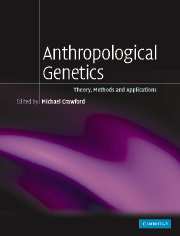Book contents
- Frontmatter
- Contents
- List of Contributors
- Preface
- Chapter 1 Foundations of Anthropological Genetics
- Part 1 Theory
- Chapter 2 Partitioning of Genetic Variation in Human Populations and the Concept of Race
- Chapter 3 Natural Experiments in Human Gene Mapping: The Intersection of Anthropological Genetics and Genetic Epidemiology
- Part 2 Methods
- Part 3 General Applications
- Part 4 Part IV The Human Diaspora
- Index
- References
Chapter 2 - Partitioning of Genetic Variation in Human Populations and the Concept of Race
Published online by Cambridge University Press: 05 June 2012
- Frontmatter
- Contents
- List of Contributors
- Preface
- Chapter 1 Foundations of Anthropological Genetics
- Part 1 Theory
- Chapter 2 Partitioning of Genetic Variation in Human Populations and the Concept of Race
- Chapter 3 Natural Experiments in Human Gene Mapping: The Intersection of Anthropological Genetics and Genetic Epidemiology
- Part 2 Methods
- Part 3 General Applications
- Part 4 Part IV The Human Diaspora
- Index
- References
Summary
In this chapter we have two major purposes in mind. Firstly, we review data on the distribution of human genetic variation, to address the question of the existence of races as valid biological entities for our species. Following this review, we focus on the concept of races as it is frequently used in biomedical and epidemiological work.
Human races
Introducing geographic variation in his classical text Systematics and the Origin of Species, Ernst Mayr (1947) makes a distinction between species in which biological changes from population to population are continuous, and species in which groups of populations with different character combinations are separated by borders. In the latter, the entities separated by borders are subspecies or geographic races. Similarly, in some human genetic textbooks (see for example Vogel and Motulsky, 1986) races are envisaged as large populations of individuals who have a significant fraction of their genes in common, and can be distinguished from other races by their common gene pool. Under both definitions, an increased level of genetic similarity among members of a race is the result of shared ancestry.
Human races have been the subject of intense scientific scrutiny long before genetics existed. A description of the rationale of these studies, and of the related debate on monogenism versus polygenism (in today's terms, mono- or poly-phyletic origin of humans) is in Cohen (1991) and a summary of modern studies quantifying genetic differences within and between major human groups is in Barbujani (2005).
- Type
- Chapter
- Information
- Anthropological GeneticsTheory, Methods and Applications, pp. 19 - 37Publisher: Cambridge University PressPrint publication year: 2006
References
- 4
- Cited by



